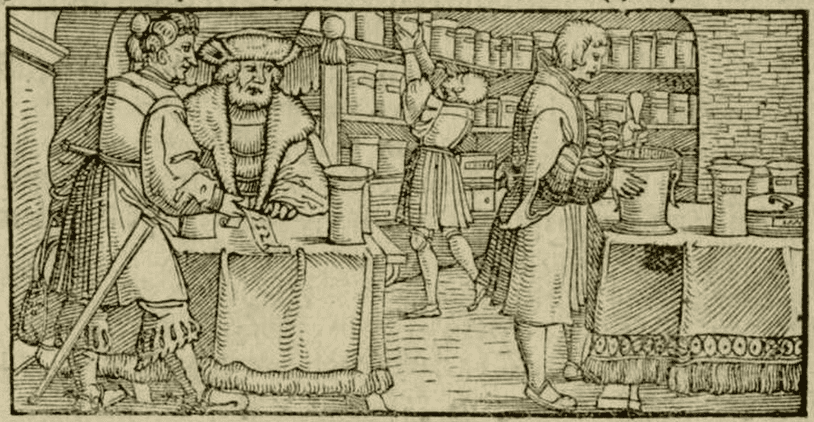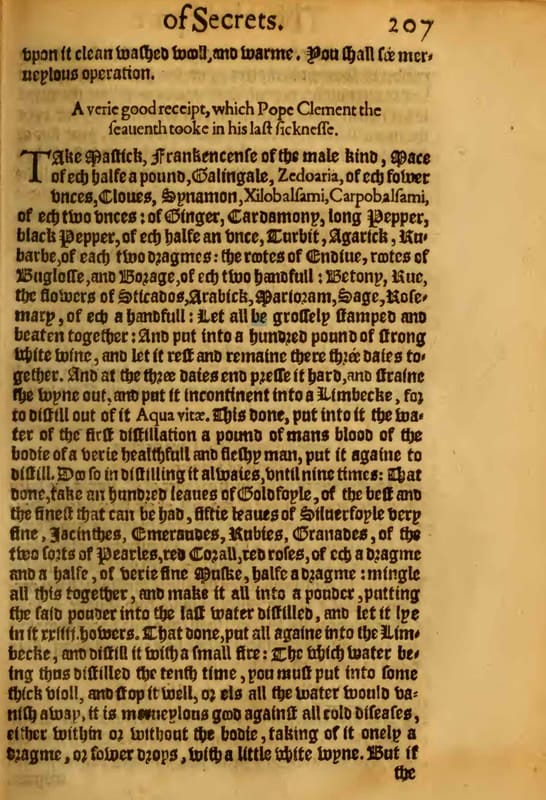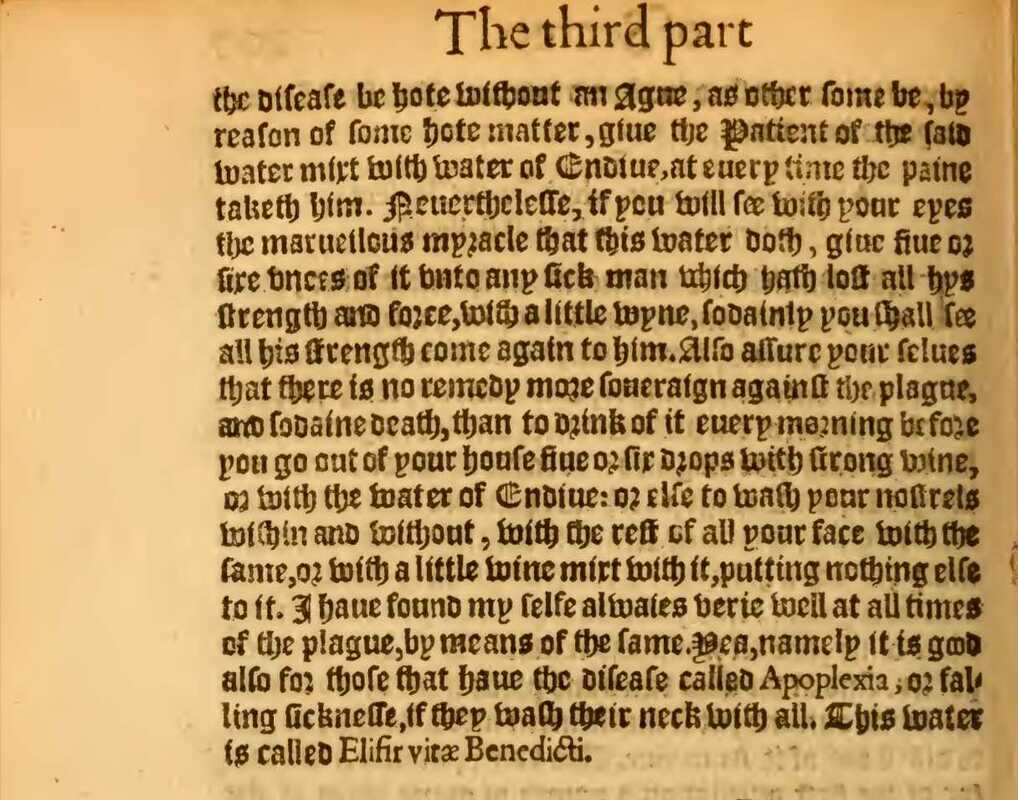Elixir Vitae Benedicti
The Blessed Water of LifeAdam Tate, April, 2024
 The Elixir Vitae Benedicti, or the “The Blessed Water of Life” is a formula in The Secrets of the reverend Alexis of Piedmond (1595). This text is a compilation of various formulas for not only medicine, but also cosmetic and industrial recipes. It is generally reckoned to be penned by Girolamo Ruscelli (mid 16th century), Alexis of Piedmond being a Pseudonym.
The Elixir Vitae Benedicti, or the “The Blessed Water of Life” is a formula in The Secrets of the reverend Alexis of Piedmond (1595). This text is a compilation of various formulas for not only medicine, but also cosmetic and industrial recipes. It is generally reckoned to be penned by Girolamo Ruscelli (mid 16th century), Alexis of Piedmond being a Pseudonym.It appears to be a collection of experienced and effective formulas, many of the medicinal recipes contain remarks as to their proven effectiveness, and in some instances, case histories of where the medicine had been used successfully.
The formulas range from simple kitchen remedies, to elaborate compounds requiring distillation or other more complex processes.
One of the interesting formulas is Elixir Vitae Benedicti, or, The Blessed Water of Life. Many famous physicians in the 15th and 16th centuries had a version of Water of Life. This is generally a medicine to support life, and according to some, promote longevity. Some “Waters of Life” were simple herbal tiinctures or distilled spirits, usually containing warming medicines to warm and cherish the Yang. Other were alchemical preparations believed to promote longevity.
The current Water of Life is interesting in the it contains a number of herbs distilled into a spirit, the addition of Human blood from a young and healthy man, as well as a number of gem stones, gold, silver and musk. The distillation of human blood is interesting when used as a tonic, but is not unique to this recipe. Various 16th and 17th century texts refer to distilled blood as a potent tonic.
But the other curiosity of this formula is the praise, potency and usefulness bestowed upon it. It is certainly not uncommon for texts of formulas to be embelished with overethusiastic descriptions of their properties. But is context of the text, which is comparatively more sober and rational, often giving specific case histories of treatments which is generally rare of such collections of prescriptions from the time.
The Formula:
Elixir Vitae Benedicti
Herb NameMasticFrankincense Mace Galangal Zedoary Clove Cinnamon Balsam wood Balsam fruit Cardamon Ginger Long Pepper Black Pepper Turbith Agaric Rhubarb Endive root Borage root Bugloss root Betony Rue Stoechas Marjoram Sage Rosemary flower |
|
Then add the following to the Spirit:
Herb NameGold leafSilver leaf Jacinth Emerald Ruby Garnet Pearl (2 sorts) Red Coral Rose Musk |
|
The stones must all be very well levigated and left to steep in the Spirit for 24 hours. Distil with a gentle heat and cohobate off the stones 10 times. Cohobation is the act of taking the spirit just distilled and adding it again to that which was distilled and redistilling. Store the Spirit in a tightly closed jar.
Uses:
“Marvellous good against all Cold diseases”
“If you will see with your eyes the marvellous miracle that this water does, give 5 or 6 ounces of it unto any sick man which has lost all his strength and force, with a little wine, suddenly you shall see all his strength come unto him”
“Also assure yourselves that there is no remedy so soveriegn against the Plague, and sudden Death, than to drink it every morning before you go out of your house 5 or 6 drops with strong wine … I have found myself always very well at all times of the Plague, by means oif the same”.
“It is good also for those that have the disease called Apoplexia, or Falling Sickness, if they wash their neck with it”
The text also says it can be also be used externally for all Cold Diseases, and can be rubbed on the inside of the nostrils to preserve infection during the Plague.
Dose: 4–6 drops, up to 1 dram, taken in wine.
Conclusion
This is a potent medicine and representative of a large number of such potent distilled Spirits containing numerous aromatic medicines. This is interesting in that it has Human Blood added, as well as distilling Gem stones and Gold and Silver.
The Water distilled from the blood of a healthy young man was listed in various alchemical texts of the 16th and 17th centuries, the dried and powdered blood also being noted in some texts before the use of distilling apparatus. Salmon, in his Pharmacopoeia Londonensis, 1698 says this of the distilled Water of Human Blood: “The Water cures Consumptions and Hectics”, pointing to its tonic capabilities. He also notes it for Epilepsy, Paralysis, Apoplexy, and Ulcerated Lungs, noting that it is “a great Cordial”, Cordial being a term used to denote a tonic or strengthening medicine.
It is worth noting that this blood would have been drawn during bloodletting, 1 pound equally about a pint which is commonly taken when a blood donation is given. Secondly, a number of texts stated that blood from a Pig or Sheep could be substituted for Human Blood (and Blood is routinely eaten in a number of cultures, including Chinese). Thirdly, that distillation of Blood removes any danger of contracting either virus or parasites that could contaminate the Blood.
The addition of Gems stones to formulas is noted long before this text. But what is intruiging is the distillation of the spirit from the Gems. Common sense would dictate that strong spirit would liberate nothing-to-very-little from the stones and precious metals. Yet here is pure energetic medicine; a medicine working on the “Qi” aspect, as TCM would describe it. It is also reminiscent of the Gem Elixirs used by Crystal healers of today, and can also be likened to the Homeopathic medicines which are classed as “Vibrational” medicines: alcohol preparations holding the “Vibration” of the medicine. If such preparations can hold an energetic or vibrational effect effect from a Plant medicine, then surely a similar principle would apply to spirit distilled from gem stones?
The combined effect produces a highly aromatic, very piercing and penetrating remedy, warming the Yang, enlivening the Qi, and restoring the Heart, Digestion and Nervous system.
The Formula as it appears in the Text:


You may also Like:
Introduction to The Art of Distillation
Introduction to the Shang Han Lun
Myrobalans and the Triphala Formulas
Organotherapy – use of animal Organs
